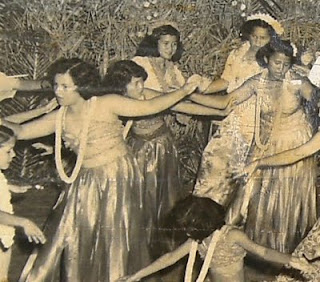 The scarlet I’iwi (ee-EE-vee) or Hawaiian Honeycreeper. Although only 6” long, this bird is one of the most spectacular and beautiful birds found in the Hawaiian Islands. It’s long peach-colored, sickle-shaped beak probes for nectar from tubular-type flowers, feeding primarily on the Ohi’a nectar, but also catching butterflies, moths, and other insects. That squeaky, irritating sound you may hear is their song…a surprise for such a beautiful bird.
The scarlet I’iwi (ee-EE-vee) or Hawaiian Honeycreeper. Although only 6” long, this bird is one of the most spectacular and beautiful birds found in the Hawaiian Islands. It’s long peach-colored, sickle-shaped beak probes for nectar from tubular-type flowers, feeding primarily on the Ohi’a nectar, but also catching butterflies, moths, and other insects. That squeaky, irritating sound you may hear is their song…a surprise for such a beautiful bird.Its orange-red feathers, which were used to make the feather capes, helmets and other apparel and symbols of Hawaiian royalty was very much valued and sought after in Hawai’i’s days of old. To get these feathers, the royal bird catcher went into the forests seeking out the trees with blossoms that attracted the I’iwi. A sticky sap was smeared on the branches of the selected trees. Often times the bird catcher would imitate the bird’s song or recite a special chant to lure more birds. Once the I’iwi landed on the sap, he would be pa’a (stuck) and easily captured.
Although the species does live in drier areas on Hawai'i as low as about 1,000', it is most commonly found above 3,200' of elevation, where disease-carrying mosquitoes are not present. I'iwi are still fairly common on most of the islands, it is rare on O'ahu and Moloka'i and no longer found on Lana'i. Most of the decline is blamed on loss of habitat, as native forests are cleared for farming, grazing, and development. Another threat has been the spread of avian malaria.
 The Raggiana is a rather large bird, measuring approximately 13” in length. Its habitat is primarily in southern and northeastern New Guinea. It is the national bird of Papua, New Guinea and appears on their national flag. The adult male has trailing orange plumes, green chin, and yellow crown and nape. The female is dull brown. They are very vocal. Flight is undulating and floppy.
The Raggiana is a rather large bird, measuring approximately 13” in length. Its habitat is primarily in southern and northeastern New Guinea. It is the national bird of Papua, New Guinea and appears on their national flag. The adult male has trailing orange plumes, green chin, and yellow crown and nape. The female is dull brown. They are very vocal. Flight is undulating and floppy.Many people consider the Raggiana among the most beautiful and interesting of all birds because of their spectacular plumage and intricate mating dances. Plumage varies from all black to red, orange and iridescent green, to muted shades of brown. They are related to crows, and share such characteristics as strong feet and toes, a strong beak, good flying endurance, and loud voices.
The PNG government allowed the capture and export of three species by Honolulu Zoo in 1987. Since then Honolulu Zoo has successfully propagated all three: Raggiana Bird of Paradise (Count Raggia's Bird of Paradise, or simply the Raggia), Magnificent Bird of Paradise and Superb Bird of Paradise.

Red Crested Cardinal (Paroaria coronata) is a bird species in the tanager family of birds. It is found in northern Argentina, Bolivia, southern Brazil, Paraguay and Uruguay. It is about 7.5 “ in length and was introduced to Hawai’i in 1930 from South America. The Red-crested Cardinal feeds on the ground for seeds, plant matter, insects, and fruit. Often found in pairs or small family groups. Also known as the Brazilian Cardinal. With its introduction to Hawai’i, it has become one of its more common birds.
Whoops, almost forgot…these paintings are oil on 8x10 canvas board. They are just finished so the paint is still wet. I still need a little bit more tweaking. You can contact me my email if you are interest in purchasing. Hope you enjoyed this posting. My apologies for the poor quality of the photos.
> There are 3 ways you can make a real difference to this blog.
1. Share the link to this site with just one other artist, art collector, or someone who would be interested in myths and legends of Hawai'i.
2. Post your thoughts in the Comments section.
3. Email your ideas and/or suggestions on what you would like to read/see more of to lokeforrest@comcast.net






